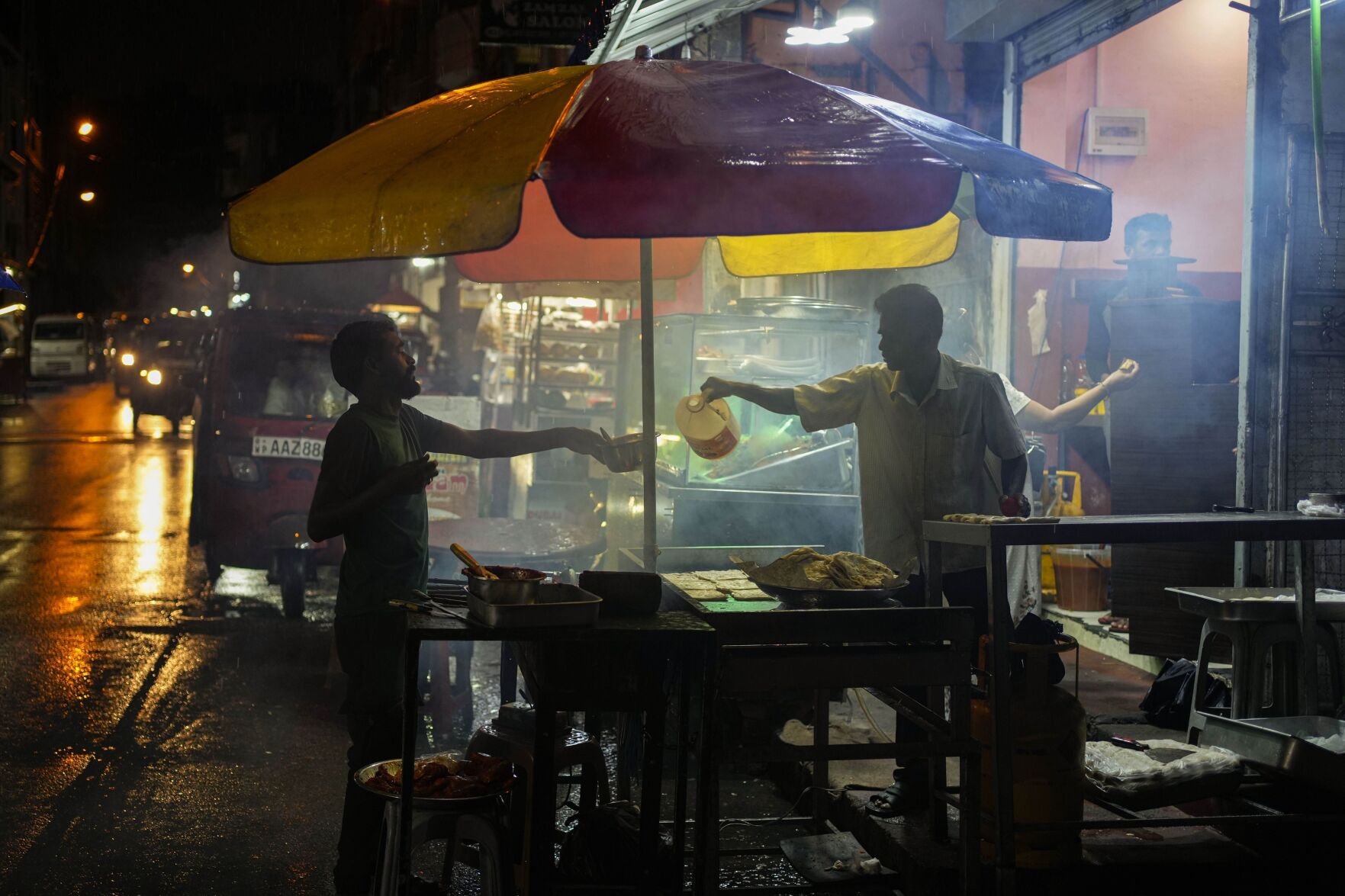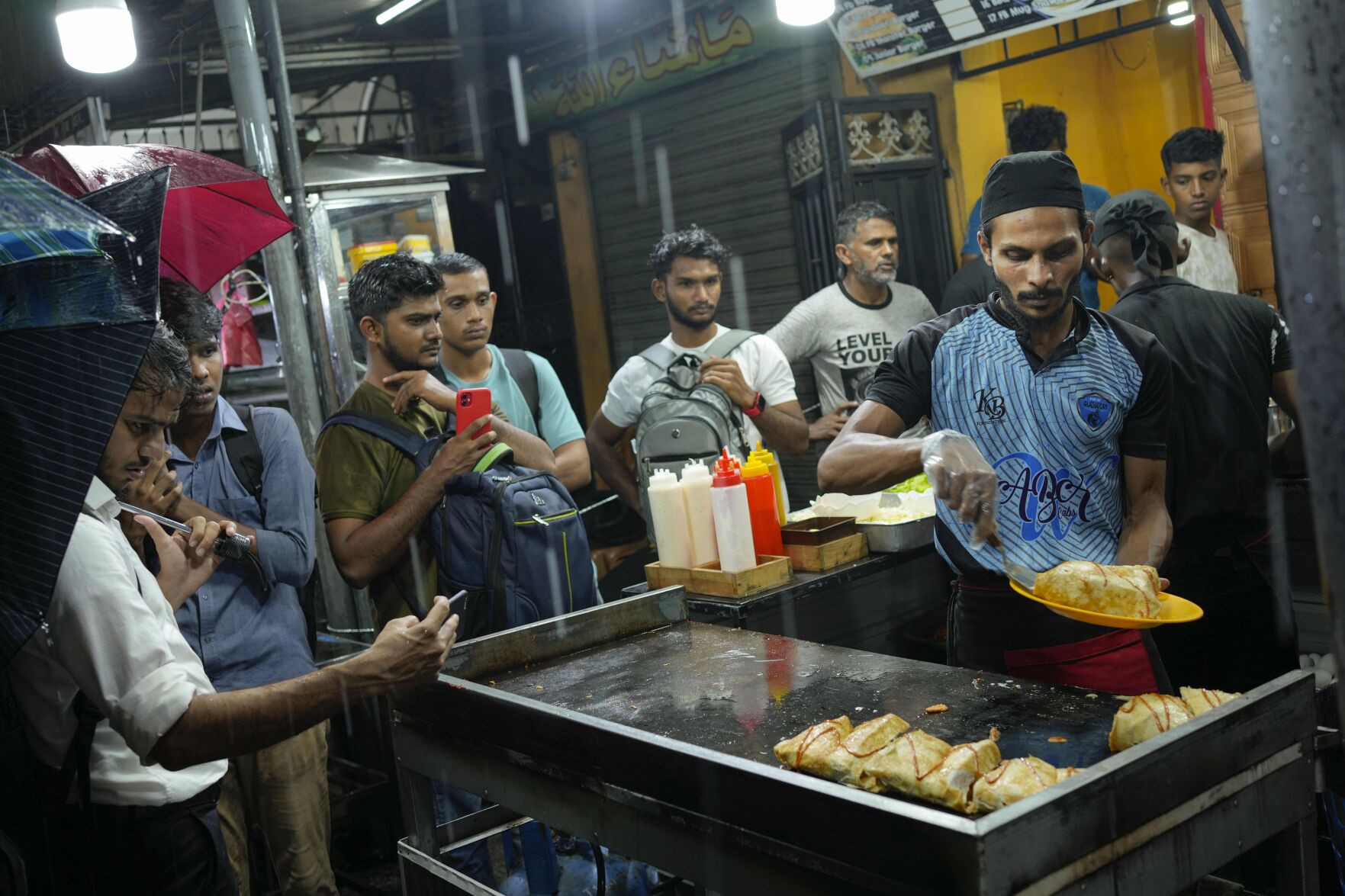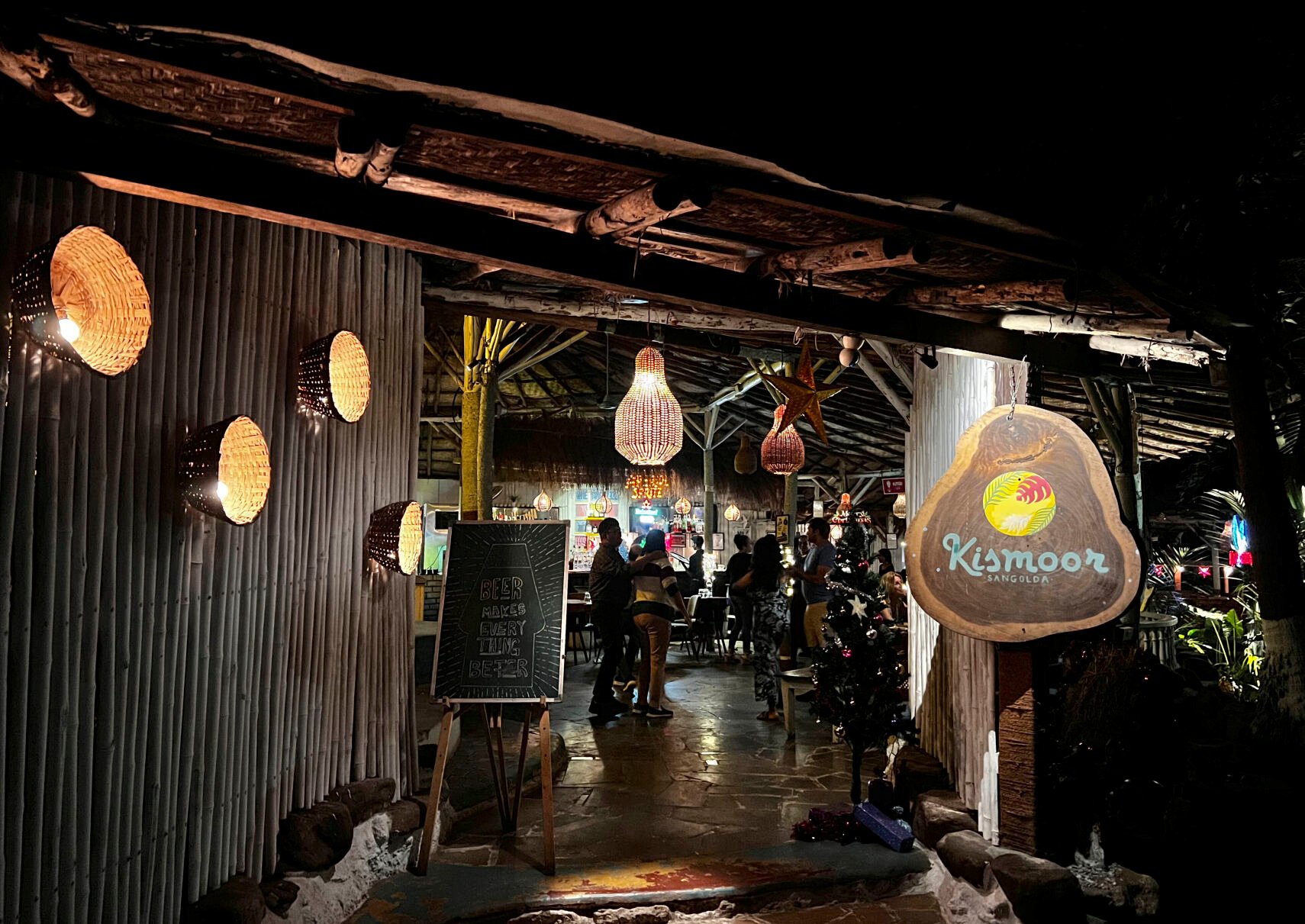NEW DELHI — Hotels and restaurants across South Asia have had to adapt and reimagine dining out since the pandemic ripped through the region, forcing many out of business.
Those that have survived are tapping local sources and going online.
In India, from hole-in-the-wall casual eateries to fine dining, restaurants were devastated by lockdowns and virus outbreaks, with millions losing their jobs since COVID-19 hit in early 2020.

Eranga Jayawardena, Associated Press
A street vendor sells food Dec. 28, 2022, in Colombo, Sri Lanka.
In neighboring Sri Lanka, where the tourism-driven economy also has been hammered by political upheavals and shortages, the situation remains dire.
Saman Nayanananda, a food and beverage manager at a hotel chain in the Sri Lankan capital Colombo, says going local for food sourcing and menu offerings is vital.
Nayanananda, who was in New Delhi recently for the South Asian Food for Thought festival, survived a devastating tsunami in 2004 that killed 230,000. He lived through a prolonged civil war that ended in 2009 and witnessed the aftermath of deadly 2019 Easter terrorist attacks. After every calamity, the economy managed to get back on its feet.
The struggle to recover for the nation of 22 million is infinitely tougher given Sri Lanka’s troubles with debt, fuel and food shortages, said the 50-year-old hospitality industry veteran.
“We had lot of challenges, including raw materials and the transport problems. A year after COVID, all hotels started food delivery. We were slowly recovering and then this economic crisis came. We ran out of both imported and local materials. Again back to zero,” said Nayanananda, who lost his job at a tourist resort in 2020 as everything shut down.
“We recovered from terrorism, from the tsunami, but this crisis, it has broken the middle class,” he said. With food inflation at 70% and hard currency to buy from abroad in short supply, going local both in terms of food sourcing and menu offerings is the only option.
“We came out with the concept of grow and sell. We replaced imported production with local production, coming up with innovative food items,” he said, mentioning dishes using locally grown sweet potatoes, cassava, yams and cowpeas, or black-eyed peas.

Eranga Jayawardena, Associated Press
People gather around a street food vendor Dec. 28 in Colombo, Sri Lanka.
Across the region, hotels and restaurants are finding past business models obsolete. That’s forcing a reset in strategies as investments recover to meet rising demand from hungry diners eager to eat out again.
India’s food services market is expected to grow to $79 billion by 2028 from $41 billion in 2022, according to a report by the Francorp and restaurantindia.in. But the sector will still face supply delays or shortages, the report says.
Maneesh Baheti, founder and director of the South Asian Association for Gastronomy, said that the pandemic has raised awareness about health concerns and food sourcing, leading the industry to adopt more sustainable practices.
That includes offering dishes made with locally sourced ingredients.
“Eating fresh local produce according to season, returning to diets rich in nuts, legumes and green leafy vegetables, are trends that are here to stay as they engage customers who are now a health conscious-aware segment with deep pockets,” Baheti said.
“The entire food industry has realized the importance of promoting better health and the potential of wellness-based menus,” Baheti added. “Eating local and eating fresh also helps in reducing the carbon footprint since the dependence on transportation and refrigeration reduces the emission of green house gases,” he said.
As the food services industry rebuilds itself, restaurant owners say some practices born out of necessity during the pandemic can offer a way forward.
Many urban communities are experimenting with plant-based diets and growing farm produce on their rooftops and in backyards.

Vineeta Deepak, Associated Press
A local restaurant is packed with patrons Dec. 29, 2022, in Goa, India.
Siddharth Bandal, a partner at the Hideaway café and bar in the western Indian state of Goa, said they’ve learned to be nimble enough to adapt to changing customer behavior.
“It possibly made the sector stronger by exposing the weak spots and the industry has shown its resilience by adapting quickly. The pandemic made everyone more alert about hygiene. There is a renewed focus on guest experience and the eateries are evolving as they respond to the shift towards healthier food,” Bandal said.
In Colombo, Nayanananda began cycling to work and growing food at home after markets ran dry and it became difficult to feed his family of four.
In Sri Lanka and elsewhere in Asia, a wave of COVID-19 infections in China after it dropped its pandemic controls has revived worries over the risk of a return to shutdowns and other restrictions. But Nayanananda says he’s hopeful.
“What is important is to learn to live with what we have in our hands,” he said.
-
How people ordered meals online in 2022, according to DoorDash
rblfmr // Shutterstock
It seems everyone craves takeout lately—and the numbers prove it. A recent report from online food ordering company DoorDash found a 15% year-over-year growth for same-store pickup orders using their app and an 11% growth for same-store delivery orders. Additionally, 37% of respondents ordered delivery more often than last year, and 41% said the same for picking up an order, according to 2022 survey data.
Interest doesn't just stop there: 37% of consumers dined indoors more often than last year, and nearly 1 in 5 decided to dine al fresco more often. Whether eating at a restaurant or taking a meal to go, the message seems clear—diners value the simplicity of not having to cook a meal themselves as life slowly comes back to "normal" after the onset of the pandemic.
According to the National Restaurant Association, 62% of adults said they're more likely to order takeout or delivery now compared to before the COVID-19 pandemic. Industry sales are expected to hit $898 billion in 2022, but the industry continues to struggle with the repercussions of food shortages during the pandemic years. Six percent of operators experienced supply delays or shortages of key food or beverage items in 2021, and supply chain challenges have continued through 2022.
So how do restaurant trends from last year compare to now? Task Group looked at trends in how people ordered meals online in 2022, according to data from DoorDash and research from industry sources like the National Restaurant Association.

rblfmr // Shutterstock
It seems everyone craves takeout lately—and the numbers prove it. A recent report from online food ordering company DoorDash found a 15% year-over-year growth for same-store pickup orders using their app and an 11% growth for same-store delivery orders. Additionally, 37% of respondents ordered delivery more often than last year, and 41% said the same for picking up an order, according to 2022 survey data.
Interest doesn't just stop there: 37% of consumers dined indoors more often than last year, and nearly 1 in 5 decided to dine al fresco more often. Whether eating at a restaurant or taking a meal to go, the message seems clear—diners value the simplicity of not having to cook a meal themselves as life slowly comes back to "normal" after the onset of the pandemic.
According to the National Restaurant Association, 62% of adults said they're more likely to order takeout or delivery now compared to before the COVID-19 pandemic. Industry sales are expected to hit $898 billion in 2022, but the industry continues to struggle with the repercussions of food shortages during the pandemic years. Six percent of operators experienced supply delays or shortages of key food or beverage items in 2021, and supply chain challenges have continued through 2022.
So how do restaurant trends from last year compare to now? Task Group looked at trends in how people ordered meals online in 2022, according to data from DoorDash and research from industry sources like the National Restaurant Association.

-
How people ordered meals online in 2022, according to DoorDash
buryakphoto // Shutterstock
When ordering takeout, service is just as important for consumers as the convenience of preparing and delivering a meal. A DoorDash report found nearly 3 in 4 consumers chose a delivery method based on the quality of experience, 69% stated the importance of an accurate delivery time, and 69% valued quality customer service.
Plus, while customers could call a restaurant to order, nearly all enjoyed using a third-party app that allowed them to save their delivery information for easy checkout. Almost half said they enjoyed the convenience of having their delivery information saved (up 9% from 2021), and 44% said they wanted to be able to re-order their last meal easily. Easy checkout processes were also valued, with 41% stating they enjoyed having their payment information saved to make future orders with a click of a button.
buryakphoto // Shutterstock
When ordering takeout, service is just as important for consumers as the convenience of preparing and delivering a meal. A DoorDash report found nearly 3 in 4 consumers chose a delivery method based on the quality of experience, 69% stated the importance of an accurate delivery time, and 69% valued quality customer service.
Plus, while customers could call a restaurant to order, nearly all enjoyed using a third-party app that allowed them to save their delivery information for easy checkout. Almost half said they enjoyed the convenience of having their delivery information saved (up 9% from 2021), and 44% said they wanted to be able to re-order their last meal easily. Easy checkout processes were also valued, with 41% stating they enjoyed having their payment information saved to make future orders with a click of a button.
-
-
How people ordered meals online in 2022, according to DoorDash
Dragon Images // Shutterstock
Although takeout is popularly seen as an option for lunch and dinner, early risers also sought convenient options to get a meal in the morning. DoorDash found morning orders between 5 a.m. and 10 a.m. saw a threefold increase between 2021 and 2020, as more people considered ordering delivery for breakfast and brunch. Who wouldn't want a cup of coffee quickly delivered to their door?
Dragon Images // Shutterstock
Although takeout is popularly seen as an option for lunch and dinner, early risers also sought convenient options to get a meal in the morning. DoorDash found morning orders between 5 a.m. and 10 a.m. saw a threefold increase between 2021 and 2020, as more people considered ordering delivery for breakfast and brunch. Who wouldn't want a cup of coffee quickly delivered to their door?
-
How people ordered meals online in 2022, according to DoorDash
Simone Hogan // Shutterstock
Thirty-seven percent of consumers said they preferred ordering through a third-party delivery platform—up 10% compared to 2021. Only 18% of consumers preferred calling a restaurant directly, down from 27% last year.
Some consumers still ordered from the restaurant—but without picking up the phone. Thirty-eight percent said they preferred to order their delivery from a restaurant's website or app, allowing them to order on a device without calling or using a third-party system. However, the use of a restaurant's website or app has decreased, down 5% from last year.
Simone Hogan // Shutterstock
Thirty-seven percent of consumers said they preferred ordering through a third-party delivery platform—up 10% compared to 2021. Only 18% of consumers preferred calling a restaurant directly, down from 27% last year.
Some consumers still ordered from the restaurant—but without picking up the phone. Thirty-eight percent said they preferred to order their delivery from a restaurant's website or app, allowing them to order on a device without calling or using a third-party system. However, the use of a restaurant's website or app has decreased, down 5% from last year.
-
-
How people ordered meals online in 2022, according to DoorDash
Tada Images // Shutterstock
The convenience of having food delivered is also beneficial for consumers still worried about possible COVID-19 exposure—29% said they avoided going to restaurants for this reason. Half of consumers said ordering delivery was more convenient than picking up, especially when 2 in 5 customers preferred not to go out.
Along with the ease of use and convenience of an app, consumers said familiarity was key to their ordering experience. Nineteen percent of consumers said returning to a third-party app they are familiar with to order food was crucial to making their takeout experience easier.
Tada Images // Shutterstock
The convenience of having food delivered is also beneficial for consumers still worried about possible COVID-19 exposure—29% said they avoided going to restaurants for this reason. Half of consumers said ordering delivery was more convenient than picking up, especially when 2 in 5 customers preferred not to go out.
Along with the ease of use and convenience of an app, consumers said familiarity was key to their ordering experience. Nineteen percent of consumers said returning to a third-party app they are familiar with to order food was crucial to making their takeout experience easier.
-
How people ordered meals online in 2022, according to DoorDash
robin gentry // Shutterstock
DoorDash users had a specific hankering for American and Mexican food. Between January and March 2022, the most popular items ordered on DoorDash included french fries, burritos and burrito bowls, chicken nuggets and sandwiches, hash browns, and cheeseburgers.
DoorDash users also craved Japanese, Italian, and Chinese food throughout the beginning of the year.
Plus, ordering the main meal wasn't enough: DoorDash noted that consumers increasingly added appetizers, sides, and beverages to their meals.
robin gentry // Shutterstock
DoorDash users had a specific hankering for American and Mexican food. Between January and March 2022, the most popular items ordered on DoorDash included french fries, burritos and burrito bowls, chicken nuggets and sandwiches, hash browns, and cheeseburgers.
DoorDash users also craved Japanese, Italian, and Chinese food throughout the beginning of the year.
Plus, ordering the main meal wasn't enough: DoorDash noted that consumers increasingly added appetizers, sides, and beverages to their meals.
-
-
How people ordered meals online in 2022, according to DoorDash
Ground Picture // Shutterstock
Even though consumers continued going to restaurants, DoorDash's data showed more people preferred ordering takeout or picking up versus indoor dining. Eighty-six percent of consumers said they ordered takeout and pickup as much or even more than last year; 83% said they ordered more delivery.
While more than half of adults said they aren't eating at restaurants as often as they desired, according to the National Restaurant Association, the convenience of ordering takeout or delivery from a third-party app seemed to interest consumers looking for an easy way to get good food on the table.
This story originally appeared on Task Group and was produced and distributed in partnership with Stacker Studio.
Ground Picture // Shutterstock
Even though consumers continued going to restaurants, DoorDash's data showed more people preferred ordering takeout or picking up versus indoor dining. Eighty-six percent of consumers said they ordered takeout and pickup as much or even more than last year; 83% said they ordered more delivery.
While more than half of adults said they aren't eating at restaurants as often as they desired, according to the National Restaurant Association, the convenience of ordering takeout or delivery from a third-party app seemed to interest consumers looking for an easy way to get good food on the table.
This story originally appeared on Task Group and was produced and distributed in partnership with Stacker Studio.



